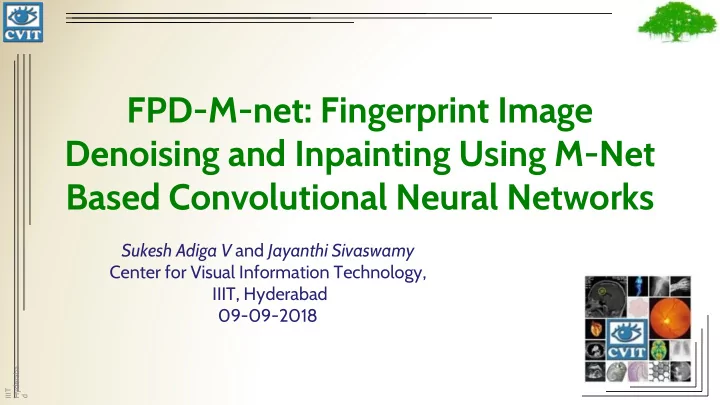

FPD-M-net: Fingerprint Image Denoising and Inpainting Using M-Net Based Convolutional Neural Networks Sukesh Adiga V and Jayanthi Sivaswamy Center for Visual Information Technology, IIIT, Hyderabad 09-09-2018 Hyderaba IIIT d
Problems to be solved • Degradation in fingerprint image quality – Example: when fingers are wet, dirty, skin dryness. • A denoising problem with signal is fingerprint and background is noise. • Incomplete information – due to the failure of sensors or wound in finger. • An inpainting problem.
Method Our view: The given image consists of an object of interest present in some background or clutter Problem to be solved is segmentation of the object (fingerprint). ❖ Hypotheses is that missing information can be handled with ❖ appropriate training, i.e. no explicit inpainting is required. Proposed solution: An architecture called FPD-M-net, based on the M-net * • originally proposed for brain structure segmentation. * Mehta et al., M-net: A convolutional neural network for deep brain structure segmentation, ISBI 2017
FPD-M-net Architecture • FDP-M-net is a encoder-decoder style of architecture with some skips connections. • Skip connections between two convolution helps in learning better features and side skip connection helps to drive fine grain details.
What is new in FPD-M-net ? Modifications done: M-net uses an initial block to convert 3D information into a 2D image. • ⇒ This is dropped. • M-net uses categorical cross entropy for the loss function. ⇒ This is replaced by a mixture of per-pixel (L1) loss and the multiscale SSIM. M-net does batch normalization after the activation function. • ⇒ This is now done before the activation function.
Training of FPD-M-Net • The network is trained end-to-end. • Input and ground truth images are padded with the edge values to suit the network and normalized to the range [0, 1]. • The network is trained to minimize a combination of per-pixel (L1) loss and the MS-SSIM loss.
Choice of loss function • In reconstruction of image, loss function should preserve intensity, luminance and these should be perceptually correlated. • The L1/L2 loss is popular but it does not correlate well with human perception. • Structure similarity index (SSIM) metric is a better alternative. – the multi-scale SSIM, addresses scale issue well. • Proposed loss function: where δ is weight parameter and is set to 0.85*. * Zhao et al., Loss functions for image restoration with neural networks. IEEE Transactions on Computational Imaging (2017).
Dataset • The dataset* consists of a pair of degraded and ground-truth fingerprint images generated by using the software: Anguli: Synthetic Fingerprint Generator . Dataset Number of images Training 75,600 Validation 8,400 Test 8,400 * Dataset is provided by the ChaLearn competition, ECCV 2018.
FPD-M-Net network parameters • The FPD-M-Net was trained for 75 epochs using SGD optimizer. The network parameter is tabulated below: Parameter First 50 epoch After 50 epoch Learning Rate 0.1 0.01 Nesterov momentum 0.75 0.95 Decay rate 0.00001 0.00001 Batch size 8 8 • Network was implemented* in Keras using Theano backend and trained for a week using NVIDIA GTX 1080 GPU. * Code : https://github.com/adigasu/FDPMNet
Results • Quantitative of performance: Set MSE ↓ PSNR ↑ SSIM ↑ validation 0.0270 16.5149 0.8255 test 0.0268 16.5534 0.8261 • Our method achieves the overall 3rd rank in the Chalearn Inpainting Competition Track 3−Fingerprint Denoising and Inpainting. • Final results: Team MSE ↓ PSNR ↑ SSIM ↑ CVxTz 0.0189 (1) 17.6968 (1) 0.8427 (1) rgsl888 0.0231 (2) 16.9688 (2) 0.8093 (3) hcilab 0.0238 (3) 16.6465 (3) 0.8033 (4) FPD-M-Net 0.0268 (4) 16.5534 (4) 0.8261 (2)
Results Row 1 : Input image of degraded fingerprint Row 2 : Results of segmentation (output of FPD-M-Net ) Row 3 : Ground-truth Note: Automatic filling is successful ● (c) and (d) versus (g) and (h) ○ Weak prints are also recovered ● (a) and (e) ○ Robust to even strong background clutter ● (b) and (f) ○
Summary and Conclusion • A segmentation formulation was shown to handle both denoising and inpainting of fingerprint images, simultaneously. • FPD-M-Net is robust to strong background clutter, weak signal and performs automatic filling effectively. • Good perceptual results for both qualitatively and quantitatively indicate the effectiveness of the MS-SSIM loss function.
Any questions? E-mail: sukesh.adigav@research.iiit.ac.in sukesh.adiga@gmail.com Phone Number: +91 9743493614
IIIT Hyderabad THANK YOU
Recommend
More recommend